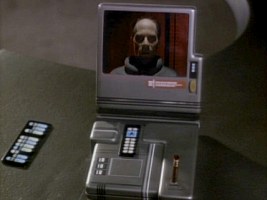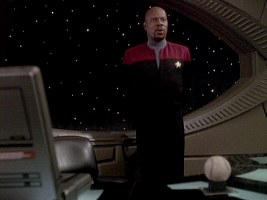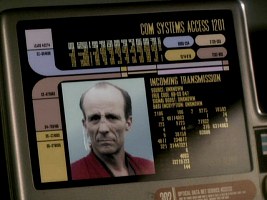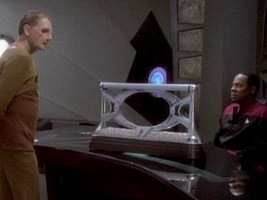Variations of the DS9 Desktop Monitor
by Jörg Hillebrand and Bernd Schneider
1 DS9 Federation Monitor 2 Alien Variations 3 Cardassian Monitor 4 DS9 Flatscreen Monitors
For starters, there is no consistent name for the device under investigation, the desktop monitors of the 24th century which look like present-day laptop computers. Regardless of the nature of the device which, by a 21st century definition, could be either a fully-fledged computer or just a terminal/viewer with a control interface, different designations show up in dialogues, like "monitor" in TNG: "Ensign Ro" or "terminal" in TNG: "Unification I". The screenplays refer to it as a "computer", "computer terminal", "desktop terminal", "desktop monitor", "desktop computer" or "desktop viewer". At Memory Alpha an agreement has been achieved to call it "desktop monitor", and we will follow this suggestion in our article.
An important point of interest is that each of the three basic models which existed over the years can be attributed to a specific series:
- The TNG model served as a Federation monitor just in TNG. For ten years it spawned countless alien variants, in TNG as well as in other Star Trek series.
- The second one is the DS9 model (this article) which was modified to alien monitors likewise of which some appeared in Star Trek Voyager too.
- Finally, there is the Voyager monitor as the only one that could not be seen outside the Federation, not even in a heavily modified variant.
One common characteristic of all monitors is particularly noteworthy: Although they look like the display could be easily flipped down like on present-day laptops, this is never shown in any episode (except for different and more recent designs in the TNG movies). As it appears, the monitors are rigid and not exactly space-saving devices.
A number of further monitors were constructed for the three series. They sometimes appeared in more than one series, but overall less frequently than the three main models of which more than just one or two copies seemed to exist.
The following analysis is limited to the Federation desktop monitors of the DS9 series and its alien variants, including a couple of other monitors that showed up in DS9.
The numerous variations of the this type of monitor will be scrutinized, including the frequent "upgrades" of the Federation model over the years as well as re-painted or otherwise modified props that served as monitors of various alien civilizations. Furthermore we will draw attention to bloopers and oddities pertaining to the look and operation of desktop monitors.
1 DS9 Federation Monitor
A new type of monitor was created for Star Trek: Deep Space Nine which was a necessity because all props of TNG would still be needed for another two years. The DS9 monitor is quite different from the TNG and the later Voyager model. For the first time we can see slots to insert isolinear chips and later (originally Cardassian) rods to transfer data to the screen. In contrast, in Voyager it was customary to bring a tricorder close to the desktop monitor for a wireless transmission.
Something that didn't change in DS9 was the practice of re-using backlit LCARS slides and of stock footage into which new video content was digitally inserted in post-production.
Overall the DS9 monitor was subject to less conversions than the TNG model. Furthermore there is only one basic type, colored gray, with no black or white variants.
It is also worth mentioning that in the first couple of episode Ben Sisko didn't yet have a Starfleet monitor, but was working on a Cardassian type that had been left behind by Gul Dukat. See chapter 3 for more about this Cardassian type.
1.1 Seasons 1-3
Except for a small addition in DS9: "Whispers" the DS9 monitor was hardly modified during the first three seasons.
On the front side we can see the screen area. The main switch is located on its right side. It really seems to work, as we can witness in DS9: "Battle Lines". Sisko presses the switch, whereupon the monitor shuts down and the switch protrudes a little more than before. Above the switch there is a black rectangle inside which there is a pattern of thin white and thick blue lines (model #1), or the black stripe is overall shorter, with a white bar below it (model #2). Model #1 can be found mostly in Sisko's office, the latter primarily in crew quarters.
Beneath the screen there is a red LCARS sticker with the number 302. The text, which can be deciphered, for instance, in DS9: "Homefront", is "Optical Data Net Service Access". The fine print reads:
"Just sit right back and you'll hear a tale, a tale of a fateful trip,
that started from this tropical port aboard this tiny ship."
These are the first four lines of the title song of "Gilligan's Island". The sticker was visible in practically every episode with this monitor. ;-)
Below the screen we can make out three black lines, with a silver line between the first and the second one. The base is characterized by a number of gray lines and buttons on the lower left. Furthermore a slot for isolinear chips is located on the lower right side. We can see how Sisko inserts a chip in DS9: "Battle Lines" to view Kira's old service record.
Above this rectangular slot a new round one was drilled for DS9: "The Maquis I" in order to accommodate a Cardassian isolinear rod. In this episode Gul Evek was supposed to insert such a rod to read some data. From now the device retains the two ports, one for chips and one for rods. Also in this episode, we can see the monitor for the first time outside Deep Space 9, namely on the Maquis planet Volan III.
Another addition was made for DS9: "Whispers". A small keypad with blue and white keys was supplemented because in this episode O'Brien (more or less) was intended to push some buttons to review data about starships visiting the station. The small terminal remained on the monitor.
On the rear side of the device we can see a black rectangle outline which is noticeably wider on the left and right sides. Inside this area, on the left, there is another rectangle, standing upright. On the right we can see another red sticker.
The script of DS9: "Progress" required Nog to tinker with a desktop monitor (a first time in Star Trek). This is why a small box was placed on the left side, filled with what was supposed to look like circuitry. This way it was not necessary to damage the monitor case. We can see the additional structure with the circuitry in just this one episode.
In DS9, like in every series, several shots were re-used. We can see an identical picture of the monitor in DS9: "Dramatis Personae", "The Homecoming", "The Circle" and "Armageddon Game", in chronological order.
A star map of Sector 22757 shows up on Sisko's monitor in "Dramatis Personae", once again in "The Homecoming" and finally, now clearly visible, in "Duet". It appears that the slide remained in the device for the whole time.
Furthermore, in "The Maquis I" and "The House of Quark" we are shown the same graphic entitled "Operational Status 879". Finally we can see the same text on the screen in "Destiny" and "Visionary".
1.2 Season 4: "The Way of the Warrior" to "Accession"
The monitor was remodeled twice in the fourth season. The first appearance of the device in DS9: "The Way of the Warrior" is stock footage from "Dax", thus explaining why the modifications are not yet present here.
The first thing to notice is the change of the rear side. We can observe, from the top to the bottom, a large frame, a black bar, a red label and two smaller frames. On the right side of the base we can make out something like a slot.
On the front side of the monitor the three black and one silver stripe were replaced with 2 black stripes that are farther apart. The red sticker as well as the on/off switch remain unchanged. Above the switch there are now five fat black bars. The interface on the base is now larger, with beige/blue LCARS bars on black background. The black and gray lines that were previously running across the whole area were removed. On the upper right we can make out a black, reflecting area. Something noteworthy is that during this period we almost always see an orange rod in the slot, even if the computer just serves as a simple communication terminal.
1.3 Season 4: "For the Cause" until end & Voyager
The only modification to the prop is that the stripes below the screen were rearranged once again. There are now three lines with gaps, with the colors of the lines and the base color switched in these gaps. In DS9: "Call to Arms" we can see for the first time on the rear side that the red label was moved to the very bottom. Otherwise the model can be seen without changes until the end of the series and beyond (as it will have a few appearances in Voyager).
In DS9: "The Darkness and the Light" we can see the device with the black field and the blue-white stripes once again. This is because we are looking at stock footage from "The Collaborator" when the monitor still looked like that. Of further interest in DS9: "The Darkness and the Light" is that, in the same take, we can see how the monitor looks with a simple backlit slide and then with an LCARS display created in post-production.
Furthermore we can frequently see isolinear rods plugged into the monitor.
In DS9: "A Time to Stand", "Behind the Lines" and "Favor the Bold" we have the opportunity to see the monitor outside Deep Space 9, obviously because the station is occupied by the Dominion and the Cardassians who are using their own monitors. The Federation type, on the other hand, shows up in Captain Sisko's and Admiral Ross's office on Starbase 375. Interestingly the red labels were replaced. We can see white stickers with red writing, not the other way round as usual. Furthermore the label on the rear side is now on the very top, inside the big rectangle. This change was obviously performed on only one of the two models. This is why we can see Sisko use sometimes the normal monitor with the red label and sometimes the Starbase 375 variant during the sixth season.
An astounding modification happens in DS9: "Valiant", however, not to the monitor but to the isolinear rod. The latter is clear from now, with a black and a gray stripe, instead of transparent orange. This was obviously done because the Cardassians had no business with the Starfleet desktop monitors any longer, while their isolinear rods were considered a cool supplement to the monitor. So it may have been decided to change their color to make them look Starfleet-ish. After the modification we will never see an orange rod in the monitor again.
On the Bellerophon in DS9: "Inter Arma Enim Silent Leges" we can see Admiral Ross work on the DS9 monitor, as well as on the Voyager model. Both types were obviously used in parallel on Federation ships. As the Intrepid-class Bellerophon made use of the Voyager mess hall set anyway, the Voyager monitor may have been readily available as well, without an explicit request.
Ensign Weldon and Commander Hilliard in DS9: "When It Rains...") at Starfleet Medical are two more officers with monitors with the clear-gray-black isolinear rod, this time on Earth. It seems that isolinear rods have become a standard component in Starfleet, although their use is limited to the DS9 series.
Also in this episode, we can see a new LCARS display composed of numbers and letters. It will become a standard display for trivial purposes, reappearing in "Doctor Bashir, I Presume", "Call to Arms", "His Way", "Valiant" (on "Captain" Watters's display) and "Inter Arma Enim Silent Leges" on Admiral Ross's display on the USS Bellerophon.
One more re-used graphic is visible in "The Siege of AR-558" and "Field of Fire". Finally a graphic which has not been shown since "Cardassians" in the second season, can be seen in the very last episode, "What You Leave Behind".
After this final appearance in DS9 the prop makes its way to the Voyager production, here appearing beginning in the sixth season. Curiously each time we encounter the device it is on Earth. Continuity-wise this is certainly a good thing, as we wouldn't expect equipment that must have been rotting in the ship's storage for years to suddenly show up on Voyager (although exactly this happened with some weapons...).
The first time we see the device in Star Trek Voyager is in VOY: "Pathfinder" on Earth in Barclay's apartment (with white stickers, here without the isolinear rod) as well as in Admiral Paris's office and in the Pathfinder lab (red stickers, Starfleet isolinear rod). The monitor was not changed in any fashion. In VOY: "Life Line" the monitor shows up in Dr. Zimmerman's lab on Jupiter Stations, interestingly with a white sticker on the front side and a red one on the rear. We can also see that the white sticker reads "927".
We can see the monitor for the last time as a Federation device in VOY: "Inside Man".
2 Alien Variations of the DS9 Federation Monitor
The desktop monitor was twice slightly modified to stand in as alien monitors.
2.1 Dinaali
The first time we can see it as a Dinaali desktop terminal in VOY: "Critical Care". Almost nothing was altered, only the two existing stickers were covered by the Dinaali logo. The LCARS terminal was replaced by one of the Dinaali as well. Even the isolinear rod is in place here, still transparent with a silvery and a black stripe (possibly because the Voyager Art Department was not aware that the rod was now Starfleet issue). Otherwise the monitor is completely identical to the Starfleet model.
2.2 Torothan
Finally the device can be seen in ENT: "Desert Crossing" in the office of a Torothan official. It appears that the monitor is still the very same as far as it is recognizable. The isolinear rod is still there, this time, however, without visible stripes.
3 Cardassian Monitor
3.1 Season 1
In DS9: "Past Prologue" Benjamin Sisko is using a Cardassian viewscreen in his office. Later in the same season we can still see the device, but more like background decoration, as the DS9 Starfleet monitor was introduced in DS9: "Dax". But we can see the Cardassian type again in Garak's tailor shop in DS9: "The Way of the Warrior".
This viewscreen was built from a real-life desktop lamp designed by Ron Rezek with an unusual rectangular frame.
3.2 Season 6 occupation period
When the unholy alliance of Dominion and Cardassians seizes the station, we can see the old Cardassian monitors again in "A Time to Stand", "Favor the Bold" and "Sacrifice of Angels". In the first episode after the recapture of Deep Space 9, "You are Cordially Invited", we can immediately see Sisko's monitor again. After that the Cardassian monitor was apparently scrapped (in-universe as well as in real life). Yet, it was conceded one last appearance in Mila's basement on Cardassia in "The Dogs of War".
4 DS9 Flatscreen Monitors
Towards the end of the series flatscreens became flat enough as well as inexpensive enough to serve as display devices of the 24th century. Especially in Enterprise we can see them very often.
As genuine flatscreen monitors used to have ventilation slots on their rear sides, they are easy to recognize in Star Trek. Naturally the non-functional props which appeared in TNG, DS9 and Voyager don't need any ventilation.
4.1 DS9: Prodigal Daughter
DS9: "Prodigal Daughter" is the first occurrence of a free-standing flatscreen monitor in DS9. We can see it in the office of the Tigans' mining company on New Sydney.
4.2 DS9: Field of Fire
In "Field of Fire" we can see a different type of flatscreens, this time in Ezri's as well as in Chu'lak's quarters. As an interesting feature, this monitor is supplemented with an LCARS keypad integrated into its base.
See Also
Variations of the TOS Desktop Monitor - investigation of its evolution and all variants, including TOS-like monitors in ENT and SNW
Variations of the TNG Desktop Monitor - investigation of its evolution and all variants, including the TNG movie monitors
Variations of the VOY Desktop Monitor - investigation of its evolution and all variants, including related monitors
Re-Used Props - Mobile Computers - desktop computers, handheld computers






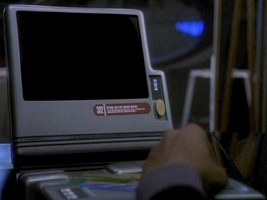
 Monitor with chip slot in DS9: "Battle Lines"
Monitor with chip slot in DS9: "Battle Lines"